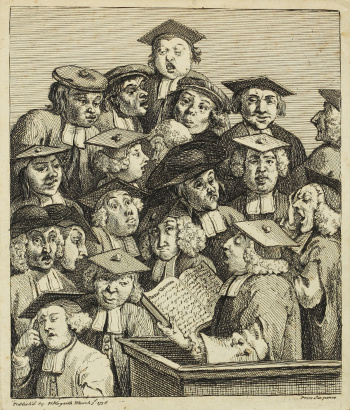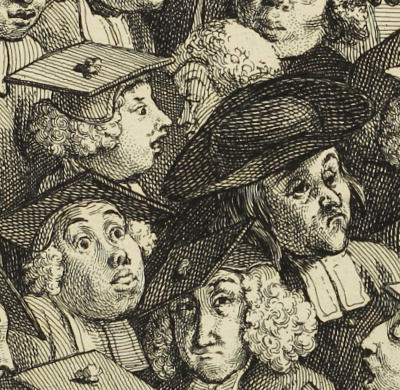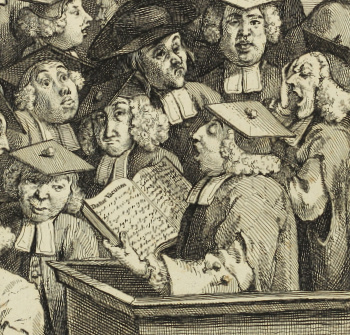AN EARLY IMPRESSION ON LAID PAPER OF HOGARTH’S ‘SCHOLARS AT A LECTURE’ (OR ‘ALMA MATER’), APPARENTLY DEPICTING WILLIAM FISHER OF JESUS COLLEGE, OXFORD
HOGARTH, William. ‘Scholars at a Lecture’. [London]: William Hogarth, 3 March 1736.
Etched and engraved print on laid paper by and after Hogarth (platemark: 218 x 184mm; sheet: 232 x 196mm), the corners tipped onto a later album leaf (240 x 298mm). (Lightly spotted, album leaf slightly creased at edges). Provenance: ink number ‘7’ in an early hand on the margin of the print – [?]late 19th-century pencil note ‘Alma Mater / Oxford’ on album leaf – Stephen John Keynes OBE, FLS (1927-2017).

Second of two states. The painter and engraver William Hogarth (1697-1764), was unable to study at university or train in a profession due to the debts his father accrued in failed attempts to publish Latin and Greek textbooks and establish a Latin-speaking coffeehouse in London. Therefore, Hogarth was apprenticed to the silver-plate engraver Ellis Gamble from circa 1714 onwards and in 1720 he set up as a copper-engraver, the same year in which he enrolled at the St Martin’s Lane Academy. In 1724 Hogarth joined James Thornhill’s drawing school in Covent Garden and his marriage to Thornhill’s daughter Jane in 1729 opened up new commissions and opportunities for him. In the early 1730s he had much success as a painter of conversation pieces, and also developed his ‘modern moral subjects’ – ‘pictorial narratives of contemporary-life subjects in series’ (ODNB) – which famously included A Harlot’s Progress (the engravings of the paintings published by subscription in 1732) and A Rake’s Progress (completed 1734). The later 1730s and 1740s saw Hogarth’s establishment as a portraitist, and eventually he would be named the ‘father of British painting’ (ODNB).


Hogarth is perhaps still best known for the satires that established his fame from 1721 onwards, including this engraved plate, ‘Scholars at a Lecture’ (also known as ‘Alma Mater’). Originally published on 20 January 1736 at a price of six pence, this second state appeared six weeks later on 3 March at the same price, clearly printing for the first time the title ‘Datur Vacuum’ on the opened book in the print (this had been invisible in the first state and was often added by Hogarth in ink). Paulson explains in Hogarth’s Graphic Works: ‘Datur vacuum’ (‘Leisure time is given for…’) is a pun on ‘vacuum’, carried out in the expressions of the various auditors. These are scholars at Oxford, wearing square-topped, round cloth, and felt hats. […] The reader is supposed to be William Fisher (d. 1761) of Jesus College, Oxford, Registrar of the University (who agreed to be drawn by Hogarth […])’.
‘Scholars at a Lecture’ would be one of four ‘Etchings of different Characters of Heads in Groups’ published together in the following year, 1737, as ‘Four Groups of Heads’, which were considered ‘caricatures’ by Hogarth’s contemporaries; the other three engravings in the group were ‘A Chorus of Singers’, ‘The Laughing Audience’, and ‘The Company of Undertakers’ or ‘Consultation of Quacks’ (Paulson, Hogarth: High Art and Low, 1732-1750 (Cambridge, 1992), pp. 122-123).
This example is from the collection of the noted bibliophile Stephen Keynes, a great-grandson of Charles Darwin and a member of the Roxburghe Club, who assembled extensive collections which were particularly rich in prints, illuminated manuscripts, and printed books.
BM, Political and Personal Satires, no. 2338; Paulson, Hogarth’s Graphic Works (1989), no. 143.
SOLD

